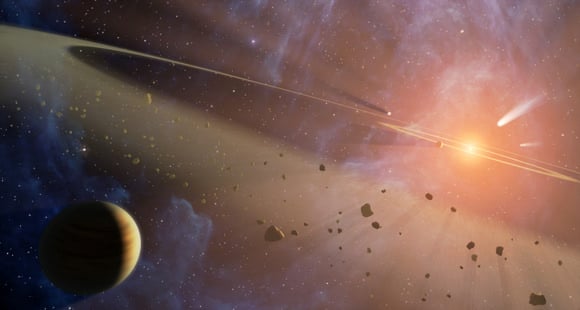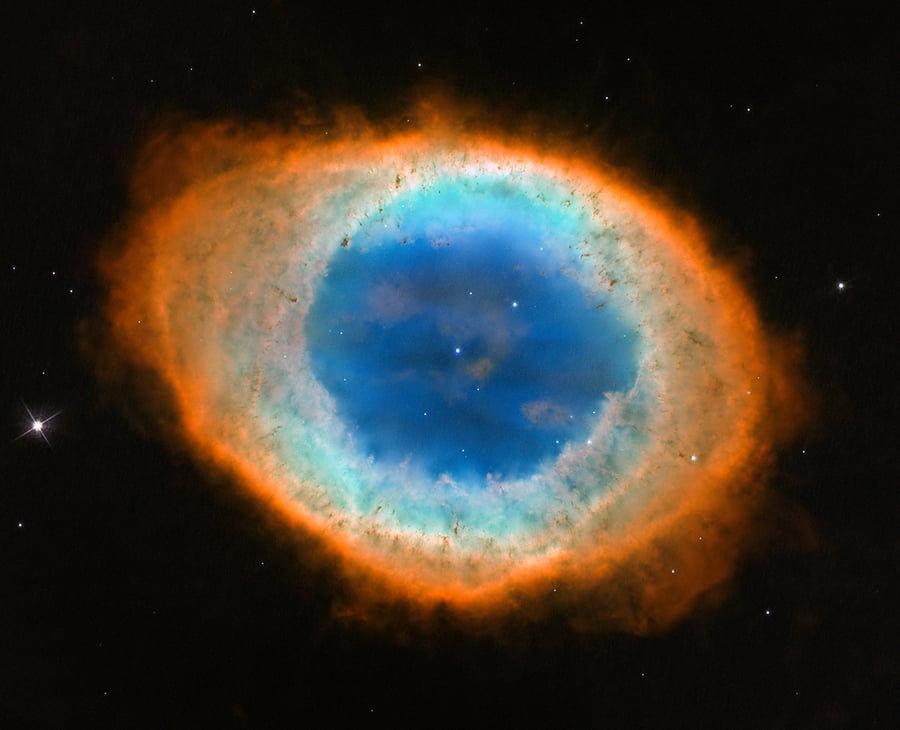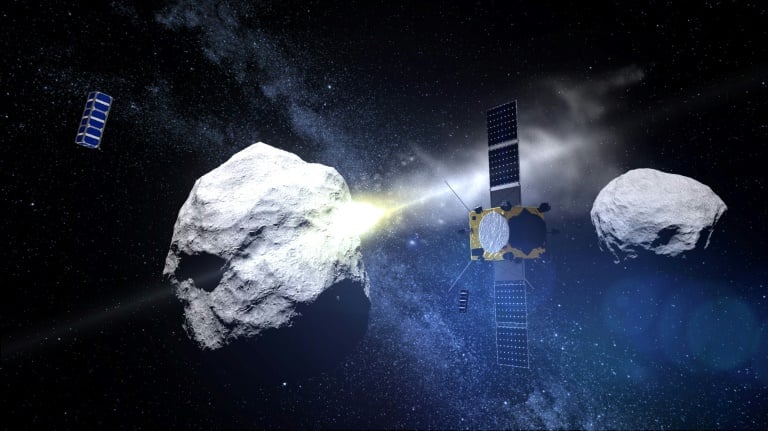
A new study by an international team of researchers has proposed a new theory about Tabby's Star, indicating that it be due to an uneven dust cloud orbiting the star
Continue reading

Continue reading

At the inaugural meeting of the newly-reestablished National Space Council, VP Mike Pence laid out the administration's plan for renewed missions to the Moon.
Continue reading

A team of scientists from the Harvard Smithsonian Center for Astrophysics have proposed a bold idea for protecting Earth against solar flare activity - placing a giant magnetic shield in orbit!
Continue reading

Continue reading

CAPE CANAVERAL AIR FORCE STATION, FL — A classified spy satellite for the U.S. governments National Reconnaissance Office (NRO) is set to kick of a launch double header this week on the Florida Space Coast with what should be a majestic overnight liftoff Thursday, Oct. 5, of a United Launch Alliance (ULA) Atlas V.
Continue reading

For their immeasurable contributions to the discovery of gravitational waves, Caltech professors Kip S. Thorne and Barry C. Barish, and MIT professor emeritus Rainer Weiss, were awarded the 2017 Nobel Prize in Physics.
Continue reading

Researchers from the Harvard Smithsonian Center for Astrophysics have devised a new way to measure the mass of our galaxy - using hypervelocity stars!
Continue reading

PLAYALINDA/KENNEDY SPACE CENTER, FL - SpaceX is targeting Saturday Oct. 7 for blastoff of the SES-11/EchoStar 105 commercial telecomsat following a successful static fire test of the first stage engines of the 'used' Falcon 9 booster, as a Florida Space Coast gator gazed on in wondrous glee as the engines fired away Monday afternoon, Oct. 2.
Continue reading

At the recent International Astronomical Congress, Lockheed Martin shared details of their Mars Base Camp, a key component in NASA"s upcoming crewed mission to Mars
Continue reading

Our own Matt Williams has his first published novel out, the Cronian Incident. A mystery novel based on the future human exploration of the Solar System.
Continue reading

Continue reading

The most powerful space telescope ever built will have to wait on the ground for a few more months into 2019 before launching to the High Frontier and looking back nearly to the beginning of time and unraveling untold astronomical secrets on how the early Universe evolved – Engineers need a bit more time to complete the Webb telescopes incredibly complex assembly and testing here on Earth.
Continue reading

Engineers at NASA's Glenn Research Center have just conducted a crucial test of the thruster that will take the Psyche mission to meet a metal asteroid.
Continue reading

A new study has indicated that the depletion of carbon from Earth-forming materials may have been essential to life here on Earth.
Continue reading

At the International Astronautical Congress this week, Elon Musk revealed his plans to conduct missions to Mars and provide aerospace trips between major cities on Earth
Continue reading

A new study by researchers from the University of Bristol has shed new light on how the planets like Earth and mars evolved to obtain the distinctive compositions they have today
Continue reading

KENNEDY SPACE CENTER, FL - NASA's OSIRIS-REx asteroid mission captured a lovely 'Blue Marble' image of our Home Planet during last Fridays (Sept. 22) successful gravity assist swing-by sending the probe hurtling towards asteroid Bennu for a rendezvous next August on a round trip journey to snatch pristine soil samples.
Continue reading

The Advanced LIGO and Advanced Virgo detectors recently made the first simultaneous detection of gravitational waves, ushering in a new era of research.
Continue reading

Continue reading

Continue reading

Continue reading

The Russian Space Agency Roscosmos and NASA announced today that Russian will be contributing modules and a docking system to the Deep Space Gateway, scheduled for construction over the next decade.
Continue reading

A new study by members of the New Horizons team has provided an explanation for Pluto's mysteries "bladed terrain".
Continue reading

A new study by a team led by the Smithsonian Institution has cast doubt on there being subsurface ice on one of Mars most-explored regions, but could also help point the way to other deposits
Continue reading

A new study by a team of international astronomers studies the newly-discovery Gaia 1 star cluster, resulting in new estimates on its age and composition
Continue reading

Continue reading

Continue reading

Located about 2300 light-years from Earth, in the direction of the Lyra constellation, is the planetary nebula known as Messier 57 (aka. the Ring Nebula)
Continue reading

Continue reading

A new study by an international team of scientists indicates how future missions to Mars should look for a rare element which could indicate that life once existed there
Continue reading

An international team of scientists recently used the Hubble space telescope to spot a unique binary asteroid that behaves like a comet in in the Main Asteroid Belt.
Continue reading

NASA is working on developing a space station in a cis-lunar orbit that will serve as the jumping off point to exploring the Solar System; it's known as the Deep Space Gateway.
Continue reading

The Hyperloop One Global Challenge recently wrapped up, and one of the winners was a team who proposed building a line between Toronto and Montreal
Continue reading

At the European Planetary Science Conference in Riga this week, scientists urged Europe to remain committed to the AIDA asteroid mission
Continue reading

KENNEDY SPACE CENTER, FL - Barely a year after NASA's OSIRIS-REx robotic asteroid sampler launched on a trailblazing mission to snatch a soil sample from a pristine asteroid and return it to Earth for research analysis, the probe is speeding back home for a swift slingshot around our home planet on Friday Sept. 22 to gain a gravity assist speed boost required to complete its journey to the carbon rich asteroid Bennu and back.
Continue reading

A new study by a team of researchers from the CfA argues that a Fast Radio Burst happens with every passing second in the observable Universe
Continue reading

A new study from Brown University reveals that there may be a lot more surface ice on Mercury than previously thought
Continue reading

Continue reading

Researchers are proposing a fleet of tiny electric sail powered satellites to explore over 300 separate objects in the asteroid belt.
Continue reading

A new study by a team from the University of Bordeaux has turned the Asteroid Belt's origins on its head, claiming it started empty and gradually filled up
Continue reading

A new study from the USC Viterbi School of Engineering, with the support of NASA, has found evidence of subsurface ice on Vesta.
Continue reading

Aerospace giant Northrop Grumman will acquire Orbital ATK for approximately $9.2 billion, in a deal the companies announced Monday and they say will "expand capability" is largely "complementary" and involves "little overlap."
Continue reading

A new study by an international team of scientists takes a look at Venus' mysterious night side, which revealed some unexpected atmospheric phenomena
Continue reading

Continue reading

A new study by scientists from the University of Texas at Austin has showed how Mars has changed geologically over the past few billion years as a result of water-based erosion
Continue reading

Continue reading

KENNEDY SPACE CENTER, FL – Concluding a month long stay at the International Space Station (ISS) a SpaceX Dragon cargo freighter loaded with some two tons of NASA research samples, hardware and micestonauts returned home to make a successful splashdown in the Pacific on Sunday, Sept. 17.
Continue reading

A new study by a team of astronomers from the UK and Switzerland explores how Planet 9 could have ended up on the outskirts of our Solar System
Continue reading

TITUSVILLE/CAPE CANAVERAL, FL – NASA's Kennedy Space Center, the KSC Visitor Complex and Cape Canaveral Air Force Station have reopened as of today and yesterday, respectively, in the aftermath of Cat 1 hurricane force winds from Hurricane Irma that lashed the Florida Space Coast on Saturday, Sunday and Monday (Sept. 9/10/11) – forcing launch delays and leaving damaged and destroyed homes, buildings, infrastructure and launch viewing locations in its wake - see photos.
Continue reading

 Universe Today
Universe Today














































